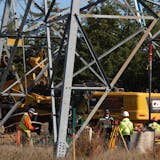SPOKANE, Wash. — The Trump administration announced plans Thursday that ease protections for sage grouse in the West, prompting an outcry by critics who say the move paves the way for widespread mining and drilling and ignores a federal court ruling.
U.S. officials plan to formally publish what are called supplemental environmental impact statements on Friday for the management of greater sage grouse habitat on public lands in seven states. Publication in the Federal Register is part of a process that could allow the plans to take effect shortly before Trump leaves office.
The plans by the U.S. Bureau of Land Management ease rules on mining, drilling and grazing across millions of acres that the agency says reflect the needs of Western communities and sagebrush-steppe habitat.
The plans "better align the BLM's management of sage-grouse habitat while addressing the circumstances and needs of each individual state," said Casey Hammond, principal deputy assistant secretary for land and minerals management.
The ground-dwelling greater sage grouse is at the center of a bitter conflict between the administration and conservationists involving how much of the West's expansive public lands should be opened to development.
Sage grouse have been in decline for decades due to habitat loss and other factors. The animals range across about 270,000 square miles (700,000 square kilometers) in parts of 11 Western U.S. states and two Canadian provinces. Their numbers have plummeted due to energy development, disease and other factors.
The birds are known for an elaborate mating ritual in which males fan their tails and puff out yellow air sacs in their chests as they strut around breeding grounds. They are not considered an endangered or protected species.
The six plans cover Idaho, Wyoming, Colorado, Utah, Nevada/northeastern California, and Oregon. A previous Trump administration plan relaxing sage grouse protections was rejected by a federal judge in 2019.


